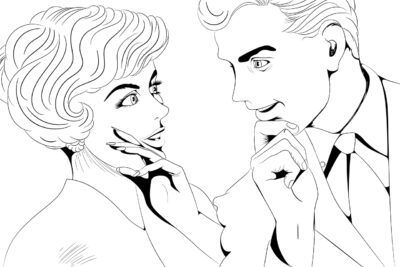 The way your characters talk — in dialogue scenes as well as in first-person narration — can not only help a reader distinguish one from the other. It can actually serve to establish who each of them is. Is he/she an optimist or a pessimist? An extrovert or an introvert? Honest or devious? Well-educated or not so much? Perhaps as important as any of these, does he/she have a sense of humor?
The way your characters talk — in dialogue scenes as well as in first-person narration — can not only help a reader distinguish one from the other. It can actually serve to establish who each of them is. Is he/she an optimist or a pessimist? An extrovert or an introvert? Honest or devious? Well-educated or not so much? Perhaps as important as any of these, does he/she have a sense of humor?
I hope no one needs to be told that we almost never speak in the same way that we write. Conversational English is an entirely different animal and must be treated as such. Rather than me expounding ad nauseam on that subject, let me recommend an expert I recently came across during one of my more fruitful YouTube sessions. David Crystal has written a number of books, but the program that caught my attention is “Let’s Talk – How English Conversation Works.” It’s one every writer or would-be writer should take to heart.
I’ve only two other general recommendations:
- Inhabit your characters. Don’t just think about and write down what he or she says; actually say it (out loud!) as if, for that moment, you were really the character. One of the great benefits of being a writer instead of an actor (and I’ve been both in my time) is that a writer gets to play all of the parts!
- Also a part of the actor’s craft think about who you’re saying it to, and why. What is the character’s reason for saying it to this person at this time? Note that while you might have a perfectly good writer’s reason for the speech (like exposition), the character needs a reason too. That isn’t to say some characters might not just ramble on in seemingly pointless conversation. But even they have a conscious or unconscious reason for doing so: a wish for attention, nervousness, an inability to tolerate silence, etc.
Word Choice
Everybody uses slang and partial sentences in conversation, but some people have a special affinity for certain words or phrases that others do not (like Hercule Poirot’s “little grey cells” or Holmes’ “the game’s afoot”).
Perhaps these reflect some past or present occupation (e.g. a sailor using nautical terms), or perhaps they reflect a person’s ethnicity or place of origin. The only caution for a writer is that if such terms are used they must be used correctly. No sailor would say “knots per hour” and no southerner would say “you-all” when referring to only one person.
The novels I write all take place in an earlier time, so it’s important for me to be sure the words and expressions I use were current in the period I’m writing about. Sometimes this requires a bit of research, but most of the information is out there if one takes the trouble to look.
Curse words may also call for a bit of thought or circumspection. I once reviewed a first novel in which the writer had a 16th Century Spanish grandee use the word coňo in polite company. Maybe he would have said this if he were aboard a ship or drilling a group of soldiers (though I’m not altogether sure of that), but certainly not in the royal court of Madrid. The word, I’m told, is common enough nowadays in Puerto Rico. But its English equivalent might still raise a few eyebrows if spoken on the floor of Congress. [
Dialects
I’ll admit my fondness for these is not to everyone’s taste. But I persist in using them, not only to help differentiate between my characters and reflect Florida’s long multi-ethnic history, but also because I think it’s fun. My recent award-winning RPLA novel contains a Scotsman, two Irishmen, several Spaniards, a couple of Creek Indians, and various Americans with equally various ways of talking.
The important thing, I think, is to try to capture the rhythm of each dialect without so many spelling changes as to make it too troublesome to scan. Sometimes a simple alteration in word order is enough to distinguish between an Irishman or a Spaniard and an American speaker.
As for creating distinctions, it may even be possible to tell two speakers apart at night in total darkness.
“Casting for contrast” doesn’t just mean establishing clearly different physical or vocal qualities for each of your characters – important enough to avoid confusion and frustration on the part of the reader. When thoughtfully and creatively used, it can go a long way toward showing the basic nature of each of them as well. And after all, showing, not telling, is what it’s all about.
